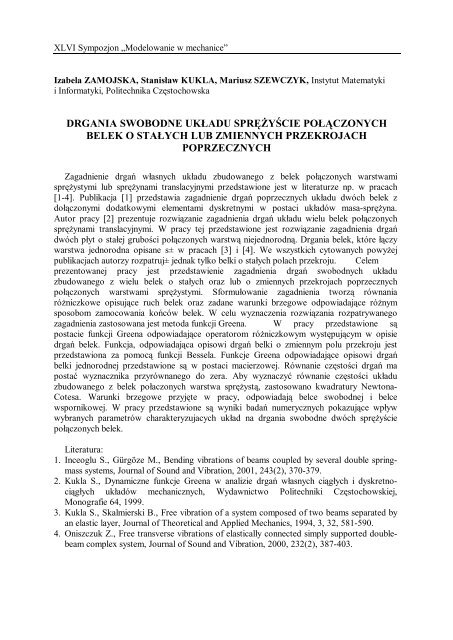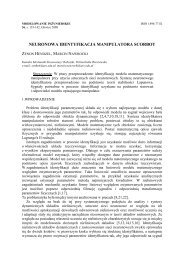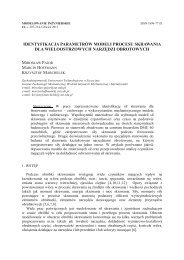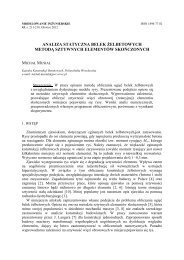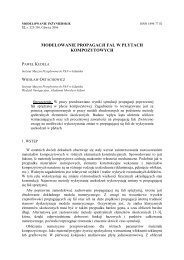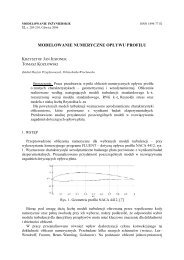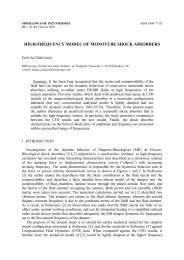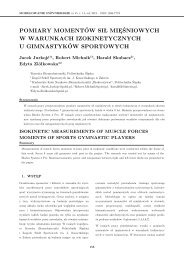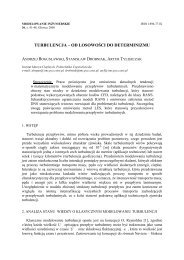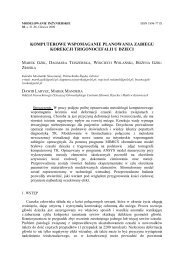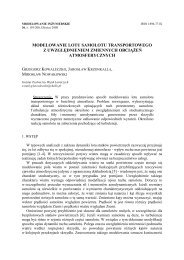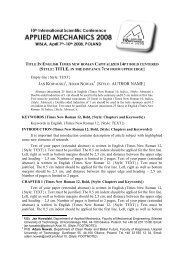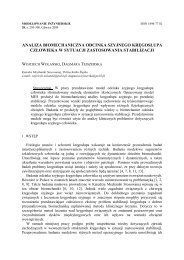drgania swobodne ukÅadu sprÄżyÅcie poÅÄ czonych belek o staÅych ...
drgania swobodne ukÅadu sprÄżyÅcie poÅÄ czonych belek o staÅych ...
drgania swobodne ukÅadu sprÄżyÅcie poÅÄ czonych belek o staÅych ...
- No tags were found...
You also want an ePaper? Increase the reach of your titles
YUMPU automatically turns print PDFs into web optimized ePapers that Google loves.
XLVI Sympozjon „Modelowanie w mechanice”<br />
Izabela ZAMOJSKA, Stanisław KUKLA, Mariusz SZEWCZYK, Instytut Matematyki<br />
i Informatyki, Politechnika Częstochowska<br />
DRGANIA SWOBODNE UKŁADU SPRĘŻYŚCIE POŁĄCZONYCH<br />
BELEK O STAŁYCH LUB ZMIENNYCH PRZEKROJACH<br />
POPRZECZNYCH<br />
Zagadnienie drgań własnych układu zbudowanego z <strong>belek</strong> połączonych warstwami<br />
sprężystymi lub sprężynami translacyjnymi przedstawione jest w literaturze np. w pracach<br />
[1-4]. Publikacja [1] przedstawia zagadnienie drgań poprzecznych układu dwóch <strong>belek</strong> z<br />
dołączonymi dodatkowymi elementami dyskretnymi w postaci układów masa-sprężyna.<br />
Autor pracy [2] prezentuje rozwiązanie zagadnienia drgań układu wielu <strong>belek</strong> połączonych<br />
sprężynami translacyjnymi. W pracy tej przedstawione jest rozwiązanie zagadnienia drgań<br />
dwóch płyt o stałej grubości połączonych warstwą niejednorodną. Drgania <strong>belek</strong>, które łączy<br />
warstwa jednorodna opisane s± w pracach [3] i [4]. We wszystkich cytowanych powyżej<br />
publikacjach autorzy rozpatruj± jednak tylko belki o stałych polach przekroju. Celem<br />
prezentowanej pracy jest przedstawienie zagadnienia drgań swobodnych układu<br />
zbudowanego z wielu <strong>belek</strong> o stałych oraz lub o zmiennych przekrojach poprzecznych<br />
połączonych warstwami sprężystymi. Sformułowanie zagadnienia tworzą równania<br />
różniczkowe opisujące ruch <strong>belek</strong> oraz zadane warunki brzegowe odpowiadające różnym<br />
sposobom zamocowania końców <strong>belek</strong>. W celu wyznaczenia rozwiązania rozpatrywanego<br />
zagadnienia zastosowana jest metoda funkcji Greena. W pracy przedstawione są<br />
postacie funkcji Greena odpowiadające operatorom różniczkowym występującym w opisie<br />
drgań <strong>belek</strong>. Funkcja, odpowiadająca opisowi drgań belki o zmiennym polu przekroju jest<br />
przedstawiona za pomocą funkcji Bessela. Funkcje Greena odpowiadające opisowi drgań<br />
belki jednorodnej przedstawione są w postaci macierzowej. Równanie częstości drgań ma<br />
postać wyznacznika przyrównanego do zera. Aby wyznaczyć równanie częstości układu<br />
zbudowanego z <strong>belek</strong> połaczonych warstwa sprężystą, zastosowano kwadratury Newtona-<br />
Cotesa. Warunki brzegowe przyjęte w pracy, odpowiadają belce <strong>swobodne</strong>j i belce<br />
wspornikowej. W pracy przedstawione są wyniki badań numerycznych pokazujące wpływ<br />
wybranych parametrów charakteryzujacych układ na <strong>drgania</strong> <strong>swobodne</strong> dwóch sprężyście<br />
połączonych <strong>belek</strong>.<br />
Literatura:<br />
1. Inceoglu S., Gürgöze M., Bending vibrations of beams coupled by several double springmass<br />
systems, Journal of Sound and Vibration, 2001, 243(2), 370-379.<br />
2. Kukla S., Dynamiczne funkcje Greena w analizie drgań własnych ciągłych i dyskretnociągłych<br />
układów mechanicznych, Wydawnictwo Politechniki Częstochowskiej,<br />
Monografie 64, 1999.<br />
3. Kukla S., Skalmierski B., Free vibration of a system composed of two beams separated by<br />
an elastic layer, Journal of Theoretical and Applied Mechanics, 1994, 3, 32, 581-590.<br />
4. Oniszczuk Z., Free transverse vibrations of elastically connected simply supported doublebeam<br />
complex system, Journal of Sound and Vibration, 2000, 232(2), 387-403.
XLVI Sympozjon „Modelowanie w mechanice”<br />
FREE VIBRATIONS OF A SYSTEM OF ELASTICALLY<br />
CONNECTED UNIFORM OR NON-UNIFORM BEAMS<br />
The free vibration problem of systems composed of beams coupled by elastic layers or<br />
translational springs has been studied in literature for example in the references [1-4].The<br />
paper [1] concerns a problem of the natural transverse vibrations of a system consisting of<br />
two clamped-free beams with several double spring-mass systems attached. Author of the<br />
reference [2] presents vibration problem of a system of many beams connected by<br />
translational springs. There is also presented a solution to vibration problem of two uniform<br />
plates coupled by non-homogeneous layer. The vibration of beams connected by<br />
homogeneous elastic layers are described by the authors of the papers [3] and [4]. In all this<br />
presented references authors consider uniform beams only. The purpose of this paper is free<br />
vibration problem of a system of many uniform and or non-uniform beams coupled by elastic<br />
layers. The formulation of the problem establish the differential equations of motion of the<br />
beams and the boundary conditions corresponding to attachments of the beam’s ends. To<br />
obtain the solution of the considering problem, the Green’s function method is used. The<br />
Green’s functions corresponding to a differential operators occurring in differential<br />
description of the beam vibration are presented. Function which corresponds to a differential<br />
description of the non-uniform beam vibration is expressed by Bessel functions of the first<br />
and second kind. The Green’s functions corresponding to description of vibration of uniform<br />
beam are presented in a matrix form. A free vibration frequency equation has the form of a<br />
determinant equated to zero. For a system of beams connected by elastic layers, to obtain the<br />
frequency equation, a quadrature of a Newton-Cotes type is used. Boundary conditions,<br />
assumed in the analysis, corresponds to a free-free and clamped-free beams. The paper<br />
presents the results of numerical investigations aimed at showing the influence of certain<br />
parameters characterising the system on free vibrations of the two elastically connected<br />
beams.<br />
References:<br />
1. Inceolu S., Gürgöze M., Bending vibrations of beams coupled by several double springmass<br />
systems, Journal of Sound and Vibration, 2001, 243(2), 370-379.<br />
2. Kukla S., Dynamiczne funkcje Greena w analizie drgań własnych ciągłych i dyskretnociągłych<br />
układów mechanicznych, Wydawnictwo Politechniki Częstochowskiej,<br />
Monografie 64, 1999.<br />
3. Kukla S., Skalmierski B., Free vibration of a system composed of two beams separated by<br />
an elastic layer, Journal of Theoretical and Applied Mechanics, 1994, 3, 32, 581-590.<br />
4. Oniszczuk Z., Free transverse vibrations of elastically connected simply supported doublebeam<br />
complex system, Journal of Sound and Vibration, 2000, 232(2), 387-403.


